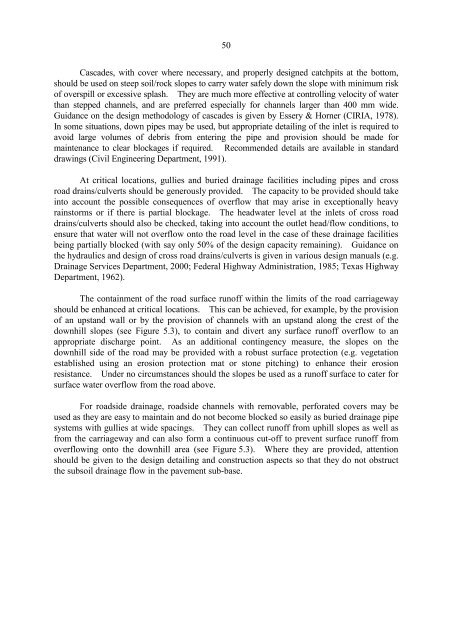Highway Slope Manual
Highway Slope Manual
Highway Slope Manual
Create successful ePaper yourself
Turn your PDF publications into a flip-book with our unique Google optimized e-Paper software.
50<br />
Cascades, with cover where necessary, and properly designed catchpits at the bottom,<br />
should be used on steep soilrock slopes to carry water safely down the slope with minimum risk<br />
of overspill or excessive splash 勾 They are much more effective at controlling velocity of water<br />
than stepped channels, and are preferred especially for channels larger than 400 mm wide 勾<br />
Guidance on the design methodology of cascades is given by Essery & Horner (CIRIA, 1978) 勾<br />
In some situations, down pipes may be used, but appropriate detailing of the inlet is required to<br />
avoid large volumes of debris from entering the pipe and provision should be made for<br />
maintenance to clear blockages if required 勾 Recommended details are available in standard<br />
drawings (Civil Engineering Department, 1991) 勾<br />
At critical locations, gullies and buried drainage facilities including pipes and cross<br />
road drainsculverts should be generously provided 勾 The capacity to be provided should take<br />
into account the possible consequences of overflow that may arise in exceptionally heavy<br />
rainstorms or if there is partial blockage 勾 The headwater level at the inlets of cross road<br />
drainsculverts should also be checked, taking into account the outlet headflow conditions, to<br />
ensure that water will not overflow onto the road level in the case of these drainage facilities<br />
being partially blocked (with say only 50 of the design capacity remaining) 勾 Guidance on<br />
the hydraulics and design of cross road drainsculverts is given in various design manuals (e 勾 g 勾<br />
Drainage Services Department, 2000; Federal <strong>Highway</strong> Administration, 1985; Texas <strong>Highway</strong><br />
Department, 1962) 勾<br />
The containment of the road surface runoff within the limits of the road carriageway<br />
should be enhanced at critical locations 勾 This can be achieved, for example, by the provision<br />
of an upstand wall or by the provision of channels with an upstand along the crest of the<br />
downhill slopes (see Figure 5 勾 3), to contain and divert any surface runoff overflow to an<br />
appropriate discharge point 勾 As an additional contingency measure, the slopes on the<br />
downhill side of the road may be provided with a robust surface protection (e 勾 g 勾 vegetation<br />
established using an erosion protection mat or stone pitching) to enhance their erosion<br />
resistance 勾 Under no circumstances should the slopes be used as a runoff surface to cater for<br />
surface water overflow from the road above 勾<br />
For roadside drainage, roadside channels with removable, perforated covers may be<br />
used as they are easy to maintain and do not become blocked so easily as buried drainage pipe<br />
systems with gullies at wide spacings 勾 They can collect runoff from uphill slopes as well as<br />
from the carriageway and can also form a continuous cut-off to prevent surface runoff from<br />
overflowing onto the downhill area (see Figure 5 勾 3) 勾 Where they are provided, attention<br />
should be given to the design detailing and construction aspects so that they do not obstruct<br />
the subsoil drainage flow in the pavement sub-base 勾

















